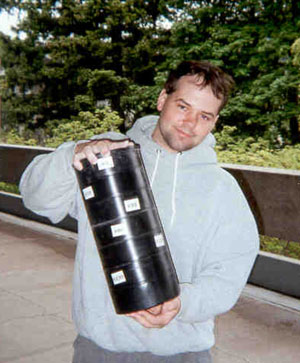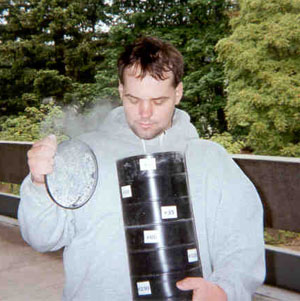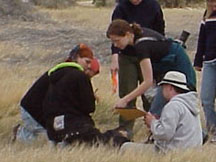| Introduction
Soil samples were taken in three locations. These were tested for flow velocity (how fast water can move through soil) and porosity (amount of water a sample could hold). We also looked at sorting, roundness of individual particles, and the percentage of light materials to dark in the composition. We used a set of sieves to separate out various particle sizes. By doing this, we were able to estimate the percent by volume of material that fell into a given size range.   Borax Lake
 Soils at eleven feet from the lake show lower porosity than those at fifty feet. This might be attributed to precipitants from the water changing the composition of the soil. Overall the average porosity at Borax Lake is 55%. Flow velocity at eleven feet is higher in the topsoil than in soil six inches down. At fifty feet, it is difficult to draw conclusions about the flow velocity from our data. The velocity is relatively high in the topsoil, but slows immensely at three inches down. At a depth of six inches, the velocity is over twice as fast as in topsoil from the same location. This discrepancy could be due to actual difference in soil composition, or it may be our error in testing. If the difference were due to soil variation, what would cause such a difference in just three inches? Alvord Hot Springs
Mickey Hot Springs
Samples taken from the mud pot had high clay components. Since
this meant that our tests for flow velocity, porosity, and sieving would
be ineffective we did not analyze these samples. The top layer actually
started forming thin pieces of shale, and the middle layer hardened into
little clumps of clay. Sediment take from the deepest level resembled
bisque-fired pottery when it dried - it turned into a clay brick exhibiting
?nice mud cracks.?
The samples taken near the first pool exhibited similar characteristics but didn?t have quite as much clay. Despite the lesser amount of clay, they had also hardened into massive globs and had developed mud cracks. These dried sediments feel powdery when rubbed between the fingers. Some grittiness indicates a slight sand component, but they predominantly exhibit composition of very fine particles.
|